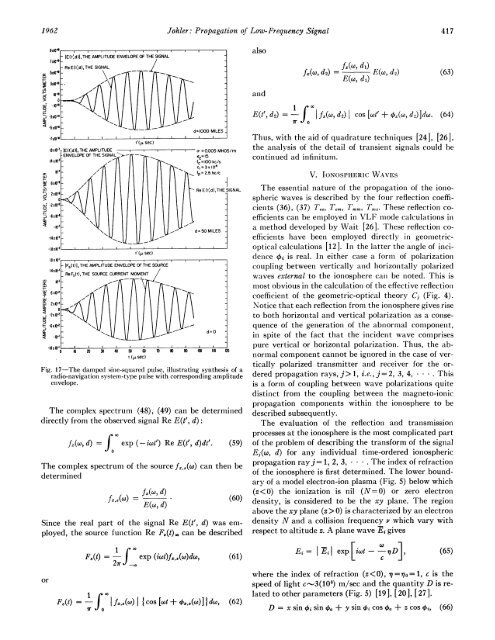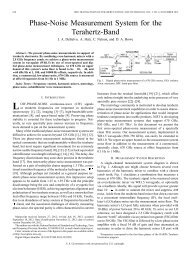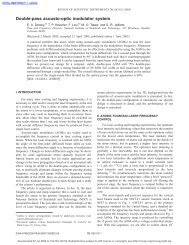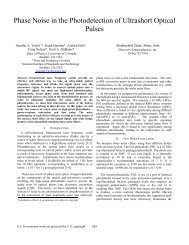Propagation Low-Frequency
Propagation Low-Frequency
Propagation Low-Frequency
You also want an ePaper? Increase the reach of your titles
YUMPU automatically turns print PDFs into web optimized ePapers that Google loves.
1962 Johler: <strong>Propagation</strong> of <strong>Low</strong>-<strong>Frequency</strong> Signal<br />
417<br />
cr<br />
n<br />
- l-i<br />
a:<br />
LD<br />
n-<br />
cr<br />
t (psec)<br />
Fig. 17-The damped sine-squared pulse, illustrating synthesis of a<br />
radio-navigationi system-type pulse with corresponding amplitude<br />
envelope.<br />
The complex spectrum (48), (49) can be determined<br />
directly from the observed signal Re E(t', d):<br />
rX<br />
fM(w, d) = exp (-iwt') Re E(t', d)dt'. (59)<br />
The complex spectrum of the source fx,8(wo) can then be<br />
determined<br />
fMw, d) (0<br />
= E(w,d)<br />
(60)<br />
Since the real part of the signal Re E(t', d) was employed,<br />
the source function Re F8(t). can be described<br />
or<br />
t'(fL sec)<br />
- IFs(t)I,THE AMPLITUDE ENVELOPE OF THE SOURCE<br />
Re Fs(t), THE SOURCE CURRENT MOMENT<br />
ex<br />
F,(t) = exp (x)z8Xdo<br />
21r co<br />
(61)<br />
1 0x<br />
F (t) = - f.a(W) I{cos [wt + x,a(cw)] I d@o, (62)<br />
7ro<br />
also<br />
and<br />
JxW2 ) fE(w,7<br />
(co, di) E(w,d2)<br />
(63)<br />
E(t', d2) = f(, (co d2) cos [wt' + 0;(w, d.)]dcd. (64)<br />
Thus, with the aid of quadrature techniques [24], [26],<br />
the analysis of the detail of transient signals could be<br />
continued ad infinitum.<br />
V. IONOSPHERIC WAVES<br />
The essential nature of the propagation of the ionospheric<br />
waves is described by the four reflection coefficients<br />
(36), (37) Tee, Tem Trrmmn Tine. These reflection coefficients<br />
can be employed in VLF mode calculations in<br />
a method developed by Wait [26]. T hese reflection coefficients<br />
have been employed directly in geomnetricoptical<br />
calculations [12 ]. In the latter the angle of incidence<br />
Xi is real. In either case a form of polarizationi<br />
coupling between vertically anid horizonitally polarized<br />
waves external to the ionosphere canl be noted. This is<br />
most obvious in the calculation of the effective reflection<br />
coefficient of the geometric-optical theory Cj (Fig. 4).<br />
Notice that each reflection from the ionosphere gives rise<br />
to both horizontal and vertical polarization as a conisequence<br />
of the generation of the abnormal componenit,<br />
in spite of the fact that the incident wave comprises<br />
pure vertical or horizontal polarization. Thus, the abnormal<br />
component cannot be ignored in the case of vertically<br />
polarized transmitter and receiver for the ordered<br />
propagation rays, j> 1, i.e., j= 2, 3, 4, . This<br />
is a form of coupling between wave polarizations quite<br />
distinct from the coupling between the magneto-ionic<br />
propagation components within the ionosphere to be<br />
described subsequently.<br />
The evaluation of the reflection and transmission<br />
processes at the ionosphere is the most complicated part<br />
of the problem of describing the transform of the signal<br />
Ej(co, d) for any individual time-ordered ionospheric<br />
propagation ray j= 1, 2, 3, . . The index of refraction<br />
of the ionosphere is first determined. The lower boundary<br />
of a model electron-ion plasma (Fig. 5) below which<br />
(z 0) is characterized by an electron<br />
density N and a collision frequency v which vary with<br />
respect to altitude z. A plane wave Ei gives<br />
Ei =<br />
|IiI<br />
exp [iwt D<br />
(65)<br />
where the index of refraction (z





